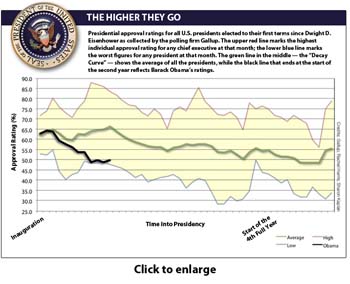The decline in President Obama’s approval ratings, from 68 percent when he took office to around 50 percent at the one-year mark, has spawned an array of agitated adjectives. To Democrats, it’s disturbing; to Republicans, it’s encouraging.
And to pundits, it warrants plenty of pontification.
But to veteran political scientist Paul Brace, the drop was entirely predictable — and not especially telling.
“Obama’s trajectory is about on par with his predecessors,” said the Rice University scholar. “[The president] started higher than many, and has experienced a drop like most.”
Along with a distinguished colleague, the late Barbara Hinckley, Brace created the “Decay Curve” of presidential popularity. In a 1991 paper published in the Journal of Politics, the political scientists showed how the poll ratings of modern American presidents (beginning with Harry Truman and using data from Gallup) follow a strikingly similar path.
Specifically, presidents tend to start out with high approval ratings, which drop precipitously in their first three years before bouncing back in year four. Those who get re-elected see the same thing happen, although the drop-off in their case is even steeper and the ultimate comeback even higher.

Brace acknowledges that many events drive presidential popularity, and some presidents’ patterns run contrary to the norm. That can be said for George H.W. Bush and George W. Bush, both of whom had major events occur early in their presidencies (the first Iraq War for Bush I, the 9/11 attacks for Bush II) that led Americans to rally around their leader.
But the Decay Curve pattern seems to be holding for Obama, at least at the one-year mark. His 18-percentage-point decline is higher than most, but that is not surprising given a) concern over the economy, which Brace and Hinkley showed is an important factor in presidential popularity, and b) his more than two-thirds approval rating at his inauguration.
“If, for instance, either Bush would have dropped 18 percent over the same period, they would have been in the range of all-time lows, because they started their terms with much lower support,” Brace noted. Since Dwight Eisenhower, however, only one president elected to his first term has polled as low as Obama at this point in his presidency: Ronald Reagan, with a 48 percent approval rating. But his fall was minor, since his initial approval rating was 51 percent.
(Two recent presidents had Obama-esque beginnings: Eisenhower at 68 percent and John F, Kennedy at 72 percent.)
So why does presidential popularity tend to gradually decline?
“My best guess is elections raise unrealistic expectations — certainly this was true with Obama — and many of these expectations can’t be realized when you get into the nitty-gritty of actual governance,” Brace said.
Also, until the opposing party chooses a presidential nominee, the president is effectively being judged against an abstract, probably unachievable ideal. That will inevitably change, and when it does, Brace expects Obama will bounce back in terms of public approval.
“Assuming there are some improvements in the economy, I suspect his approval will start rising as likely opponents become apparent for the 2012 election,” he said. “I think in this stage he is evaluated in isolation. But as the election nears he will become compared with potential opponents, bolstered by his own early campaigning for re-election, and this should produce the upswing typical of most administrations.”
Sign up for our free e-newsletter.
Are you on Facebook? Become our fan.
Follow us on Twitter.




